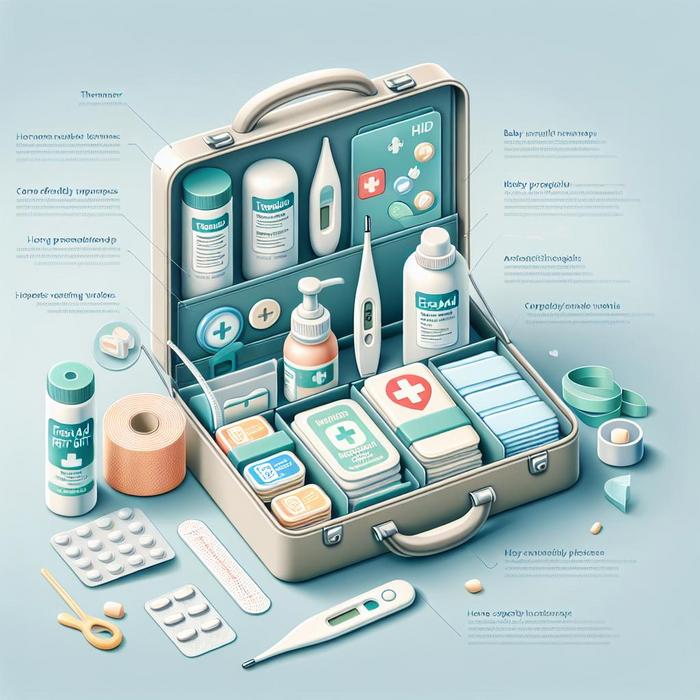A Comprehensive Baby First Aid Kit: Why It Matters
We never want to imagine our babies in distress. Unfortunately, emergencies do happen, and it’s crucial to be prepared for them. One of the best ways to ensure that we can respond to our children’s needs swiftly and effectively is by keeping a well-stocked baby first aid kit on hand.
Knowing what to include in your baby’s first aid kit can be daunting. Here, we share our insights and explain the essential supplies you should always have within your reach, as well as some home safety tips for further safeguarding your precious little one’s well-being.
The Essential Supplies for Your Baby’s First Aid Kit
Not all first aid kits are created equal. For your baby, you need to ensure that you have the right supplies that are appropriate for their age and specific needs. Here are some essential items that should never be missing from your baby’s first aid kit:
- Thermometer: A fast-reading and accurate thermometer is vital for determining if your baby has a fever.
- Adhesive bandages and antiseptic wipes: These are handy for cleaning and covering small cuts or scrapes.
- Hydrocortisone cream: Helpful in soothing insect bites or minor skin irritations.
- Saline solution and a bulb syringe: These can aid in clearing your baby’s stuffy nose.
- Infant acetaminophen: Useful in reducing fever and relieving minor aches and pains. Ensure you also have a proper dosing device.
- Oral rehydration salts: These can help with dehydration caused by diarrhea or vomiting.
For a more thorough list of what to include, consult the Red Cross anatomy of a first aid kit and the REI expert advice on first aid checklists.
Home Safety Tips for Increased Emergency Preparedness
In addition to having a well-stocked baby first aid kit, it’s crucial to follow essential home safety tips. These practices can vastly reduce the risk of accidents, giving you peace of mind.
- Ensure all medicines and cleaning products are stored in high, locked cupboards, away from your child’s reach.
- Use safety gates at both the top and bottom of your stairs until your child is confident climbing up and down.
- Securely anchor heavy furniture to the wall to avoid tipping over if your child attempts to climb.
- Keep small objects, cords, and strings out of your child’s reach to prevent choking or strangulation hazards.
Being Prepared, Even On The Go
Finally, remember that emergencies can happen anywhere, not just at home. In addition to our home baby first aid kit, we always keep a smaller, more portable version for when we are on the go. It’s easy to prepare and can be a lifesaver during travel or even just a day out at the park.
What to Include in Your On-The-Go Baby First Aid Kit
The contents of your portable baby first aid kit should be similar to your home kit, with a few adjustments to accommodate mobility. Here’s a quick checklist of items that are essential:
- Travel-size antiseptic wipes: Use these to clean small cuts or scrapes on your baby on the go.
- Compact digital thermometer: A must-have to check your baby’s temperature in a hassle-free manner.
- Small packets of infant acetaminophen: These are practical for quickly addressing fever or pain when you’re out and about.
- Mini tube of hydrocortisone cream: Ideal for soothing insect bites or minor skin irritations while traveling.
- Adhesive bandages: Smaller sizes are perfect for carrying in your portable kit for unforeseen injuries.
- Saline solution and a bulb syringe: These are necessities for dealing with a stuffy baby nose on the go.
- Oral rehydration salts: Carry these to help combat dehydration caused by diarrhea or vomiting.
For more ideas on which items to include in your first aid kit, you can consult the Mayo Clinic’s guidelines or CDC’s recommendations.
Essential Baby Safety Measures to Take When On-The-Go
To enhance baby safety away from home, consider the following points:
- Carry baby-friendly sunscreen and insect repellent to protect your baby from sunburns and bug bites.
- Always keep your baby in sight and within arm’s length to quickly react to potential dangers.
- Ensure your toddler is safely secured in a stroller or carrier when out walking.
- Avoid crowded places to minimize the risk of contagious diseases or injuries from accidental falls.
- Ensure hot drinks or foods are kept out of reach to prevent burns.
The Value of a Basic First Aid Course for Parents
While a thorough first aid kit is essential, knowing how to use its contents correctly is just as crucial. Taking a basic first aid course tailored to parents could make a significant difference in emergency situations. These courses often cover CPR for infants, choking relief, and steps to take for common injuries.
The Final Word: Always Stay Prepared
Remember, having a comprehensive baby first-aid kit — both at home and on the go — is your first line of defense in an emergency. Being aware and prepared can significantly reduce stress during these challenging moments. So, ensure you have your kits stocked and, if you haven’t already, consider taking a basic first aid course – it could make all the difference in the wellbeing of your child.

